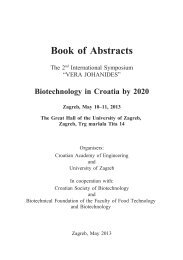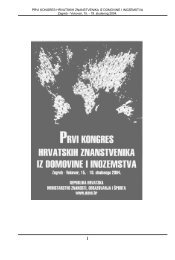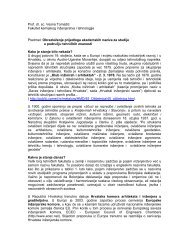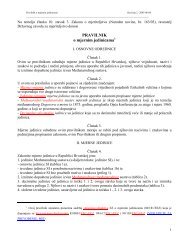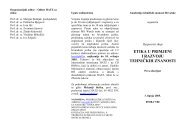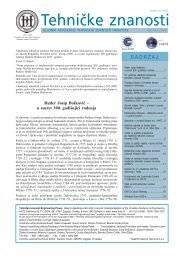annual 2010/2011 of the croatian academy of engineering - HATZ
annual 2010/2011 of the croatian academy of engineering - HATZ
annual 2010/2011 of the croatian academy of engineering - HATZ
You also want an ePaper? Increase the reach of your titles
YUMPU automatically turns print PDFs into web optimized ePapers that Google loves.
Annual <strong>2010</strong>/<strong>2011</strong> <strong>of</strong> <strong>the</strong> Croatian Academy <strong>of</strong> Engineering 11<br />
Geodetic Contribution to <strong>the</strong> Geodynamic Research<br />
<strong>of</strong> <strong>the</strong> Area <strong>of</strong> <strong>the</strong> City <strong>of</strong> Zagreb<br />
B. Pribičević, D. Medak, and A. Đapo<br />
University <strong>of</strong> Zagreb,<br />
Faculty <strong>of</strong> Geodesy<br />
email: {bpribic, dmedak, adapo}@ge<strong>of</strong>.hr<br />
ABSTRACT<br />
Paper presents 11 year long interdisciplinary research <strong>of</strong> geodynamic processes <strong>of</strong> <strong>the</strong> area<br />
<strong>of</strong> <strong>the</strong> City <strong>of</strong> Zagreb. The Geodynamic GPS-Network <strong>of</strong> <strong>the</strong> City <strong>of</strong> Zagreb represents <strong>the</strong><br />
longest and <strong>the</strong> most intensive research effort in <strong>the</strong> eld <strong>of</strong> geodynamics in Croatia. Since<br />
<strong>the</strong> establishment <strong>of</strong> <strong>the</strong> Network in 1997, several series <strong>of</strong> precise GPS measurements<br />
have been conducted on specially stabilized points <strong>of</strong> Geodynamical Network <strong>of</strong> City <strong>of</strong><br />
Zagreb with purpose <strong>of</strong> investigation <strong>of</strong> tectonic movements and related seismic activity <strong>of</strong><br />
<strong>the</strong> wider area <strong>of</strong> <strong>the</strong> City <strong>of</strong> Zagreb. The Network has been densied in 2005 in <strong>the</strong> most<br />
active region <strong>of</strong> nor<strong>the</strong>astern Mount Medvednica. Since <strong>the</strong>n, several GPS campaigns have<br />
been conducted. Processing <strong>of</strong> observation data was done with scientic s<strong>of</strong>tware GAMIT/<br />
GLOBK, developed by MIT. From this series <strong>of</strong> GPS measurements geodetic model <strong>of</strong><br />
tectonic movements has been created. In <strong>the</strong> area <strong>of</strong> interest, independent geological investigations<br />
have been conducted through even longer period <strong>of</strong> time which resulted in<br />
geological model <strong>of</strong> tectonic movements. The correlation coefcient between geodetic and<br />
geologic model has been calculated and shows high degree <strong>of</strong> correlation thus giving credibility<br />
to both methods <strong>of</strong> research. Systematic analysis has been conducted over geodetic<br />
and geologic results giving as a result unique interdisciplinary model <strong>of</strong> crust movements<br />
over wider Zagreb area. This interdisciplinary interpretation <strong>of</strong> obtained geodetic movements<br />
leads to a new scientic insight about geodynamics <strong>of</strong> <strong>the</strong> City <strong>of</strong> Zagreb area. The<br />
results <strong>of</strong> this scientic research will be used to delineate zones <strong>of</strong> potential earthquake<br />
hazard or tectonically caused landslides.<br />
Keywords: geodesy, GPS, geodynamics, GAMIT, tectonics<br />
Introduction<br />
It has been known for a long time that <strong>the</strong> wider area <strong>of</strong> Zagreb is geodynamically active,<br />
(Prelogovi, Cvijanovi 1981) (Kuk et al. 2000), (Kuk et al. 2000a), (Tomljenovi, 2002)<br />
however, <strong>the</strong>re were no data on <strong>the</strong> actual size <strong>of</strong> those movements, nor on <strong>the</strong>ir spatial orientation.<br />
The rst geodetic research in this direction was made through <strong>the</strong> implementation<br />
<strong>of</strong> <strong>the</strong> project <strong>the</strong> “Basic GPS network <strong>of</strong> <strong>the</strong> City <strong>of</strong> Zagreb” (oli et al. 1999) (Medak,<br />
Pribievi 2001).<br />
Through <strong>the</strong> realization <strong>of</strong> <strong>the</strong> project “Basic GPS-Network <strong>of</strong> <strong>the</strong> City <strong>of</strong> Zagreb” in 1997,<br />
Croatian capital got a modern, geodetic foundation <strong>of</strong> high accuracy. Network was planned<br />
as <strong>the</strong> basis for investigations <strong>of</strong> tectonic movements and related seismic activity <strong>of</strong> <strong>the</strong><br />
wider area <strong>of</strong> <strong>the</strong> City <strong>of</strong> Zagreb. Basic part <strong>of</strong> <strong>the</strong> network consists <strong>of</strong> 43 specially stabilized<br />
geodetic points to meet <strong>the</strong> specic criteria for geodynamic points. After <strong>the</strong> second<br />
series <strong>of</strong> GPS measurements in year 2001, <strong>the</strong> network has become “Geodynamic Network<br />
<strong>of</strong> <strong>the</strong> City <strong>of</strong> Zagreb” (Medak, Pribievi 2001), (Medak, Pribievi 2002), (Medak,





